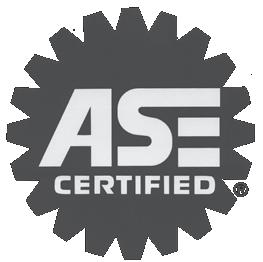On the ROAD

• BASICS OF EVs FOR FIRST-TIME BUYERS • DRIVING IN HEAVY RAIN




• BASICS OF EVs FOR FIRST-TIME BUYERS • DRIVING IN HEAVY RAIN


Buying a pre-owned vehicle can be a cost-effective way to get a reliable, affordable car or truck. The moment a new car leaves a lot, it starts do depreciate in value, according to U.S. News & World Report. After the first few years of ownership, the vehicle has lost a significant amount of its value. By buying used, consumers avoid that steep depreciation.
Pre-owned vehicle ownership is popular, as Americans buy 50 million used cars a year, according to Paul Taylor, the chief economist for the National Automobile Dealers Association. Buying a pre-owned vehicle takes a little more research and work than buying new, but that time spent can be worth it. Here’s how to navigate purchasing a used car or truck.
• Check vehicle value. Utilize a car pricing tool such as Kelley Blue Book or Edmunds to gauge the value of a used vehicle. This way you’ll have an understanding of the range of prices that are acceptable for a vehicle of a certain age, make and condition.
• Consider “certified” pre-owned vehicles. Many dealerships stand behind vehicles of a certain age and condition. Often called certified pre-owned vehicles, these tend to be lease turn-ins that are

between three and four years of age and may still be under full or partial warranties.
Certified pre-owned vehicles remove some of the worry associated with buying used since warranties will cover the repair costs of certain parts, such as the engine and drivetrain. Plus, the dealerships’ mechanics have given the vehicles health checks before listing them for sale, certifying their condition and mileage.
• Confirm financing rates. Many manufacturers are offering financing for
certified pre-owned vehicles that are as competitive as those for new cars. Shopping around for rates, both at dealerships and other lenders, can make pre-owned vehicles even more affordable.
• Exercise caution with private sellers. Buying from a private seller is a bit riskier than utilizing a dealership. That’s because the due diligence falls on you as the buyer. Ask for a vehicle history report (commonly known as the CARFAX) for any vehicle you’re considering, even if it means paying for the report. The report will list any accidents and other red flags. If a seller refuses to offer the report, pass on the deal.
• Bring a mechanic. Another safeguard is to have your own mechanic look over the vehicle before purchase. A professional will know what to look for in terms of unusual wear and tear on a vehicle that may not be evident to drivers.
• Budget for all costs. Before making any decisions, develop a used car budget that takes into consideration the total cost of owning the vehicle. This can include the monthly payment, interest, insurance, maintenance costs, and fuel costs.
Pre-owned vehicles can be great bargains, especially in an era when supply shortages are making new vehicles even more costly.
Electric vehicles are increasingly visible on roadways around the world. According to BloombergNEF, a strategic research provider covering global commodity markets, in June 2022 there were 20 million plug-in vehicles in use across the globe.
That’s an increase from only one million in 2016. As more people are drawn to EVs, drivers can exercise due diligence to learn more about them, particularly if they’re considering buying their first such vehicle.
The term “electric vehicle” encompasses a variety of cars and trucks. The following are some common categories.
• Hybrid electric vehicle: These are the most common type of hybrids. They have two power drives, which include a fuelbased engine and an electric motor with a larger battery. A computer determines when electricity or gas should be used.
The system utilizes regenerative braking that ensures the electric battery gets a little recharge every time the driver touches the breaks
• Mild hybrid electric vehicle: MHEVs use a battery and electric motor to increase the efficiency of an internal combustion engine (ICE). An MHEV does not run solely on electric power, but the ICE can be turned off and the electric motor used while braking, coasting and stopping.
• Battery electric vehicle: BEVs are powered entirely by electricity and will have no ICE or fuel tank. Users charge the battery using an electrical outlet.
• Plug-in hybrid electric vehicle: Like BEVs, PHEVs have an electric motor that is charged by plugging it in. They also have a fuel-based ICE like HEVs. Where they differ is that PHEVs can travel a considerable distance on electric power alone, while HEVs cannot.
The distance EVs can travel before needing to recharge depends on the type
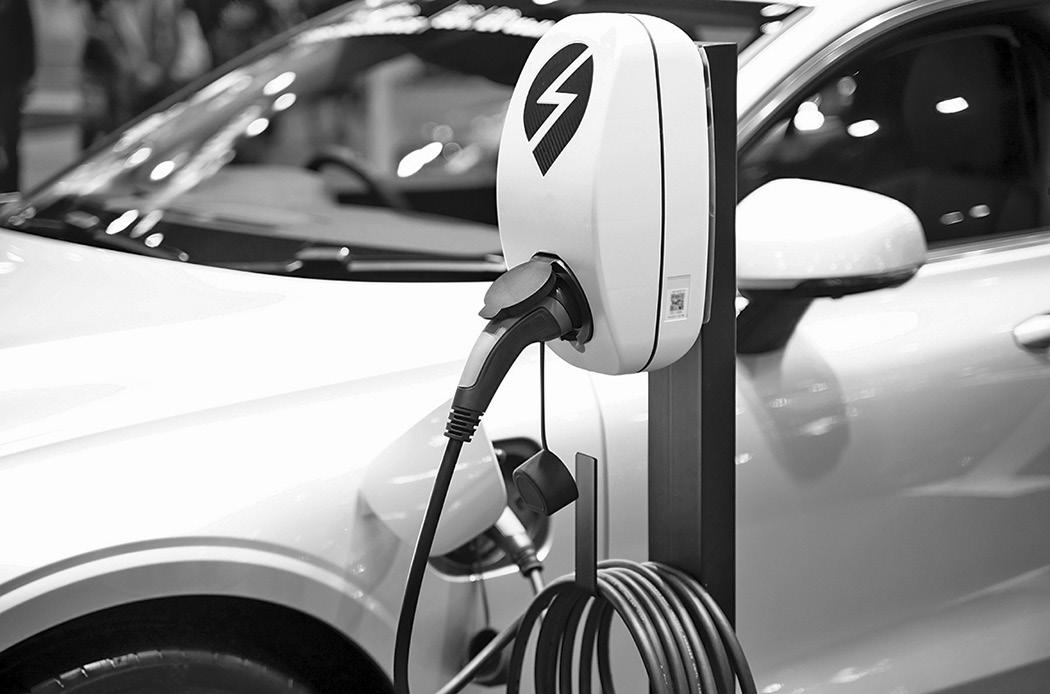
of vehicle. Most EVs have a driving range between 50 and 330 miles.
Shoppers should determine the “rangeper-charge” for the vehicle to assess if it will fit their driving needs and daily commutes. Drivers who frequently take long road trips may have to assess if a hybrid vehicle is more practical; otherwise, careful planning may be necessary to accommodate charging along the route.
Individuals who live in private homes or rentals with access to outlets may be more
inclined to invest in EVs. Charging can be done with a standard 120V outlet, but it will increase charging time considerably. Many people opt to have a 240V charger installed in a garage or driveway, which is known as “Level 2 ESVE equipment.” With this type of setup, a charge can be reached in roughy four to 6 six hours, says Valley Clean Energy. Public charging stations utilize a 480V input and can charge many EV models in about 20 to 30 minutes. Plug-in hybrid vehicles do not typically have fast charging capabilities, however.
BEVs require less maintenance than conventional vehicles because there are fewer fluids like oil and transmission fluid to change, and far fewer moving parts. EVs require minimal scheduled maintenance to electrical systems, including the battery and electrical motor. Hybrid vehicles still require the standard maintenance of gaspowered vehicles.
EVs are growing in popularity, so potential buyers can school themselves on these newer vehicles to determine if they’re the right fit for them.

The road is filled with variables that change each time drivers get behind the wheel. Whether it’s aggressive drivers, road construction crews or some other unknown, drivers can never say with certainty what they will encounter while on the road.
Mother Nature is as significant a variable as any drivers will face, and many conditions can turn otherwise ordinary trips into ordeals that put motorists’ skills to the test. Though heavy rain might not seem as difficult to navigate as snow, it’s vital that drivers recognize the threat posed by such conditions.
In fact, the Federal Highway Administration reports that each year 75 percent of weather-related vehicle crashes occur on wet pavement, while 47 percent, or nearly half, happen while rain is falling.
Such statistics are sobering and underscore how dangerous it can be to drive in rain or when roads are wet. Drivers are not helpless in such conditions, especially when they exercise caution in wet conditions.
The National Highway Traffic Safety Administration notes that drivers will have a harder time controlling or stopping their vehicles on slick roads than dry roads. And that’s the case for both experienced and novice motorists.
When driving in the rain or on wet roads, drivers should slow down, even if it requires driving a little below the speed limit. Though it can be dangerous to drive too slowly on highways, drivers can use the far-right lane on such roads, which is not considered a passing lane and is often seen as the lane designated for vehicles moving more slowly.
The NHTSA advises increasing the following distance between your vehicle and the one in front of you when driving in rain or on wet roads. An extra couple of car lengths ensures you will have more time to react and stop if vehicles ahead of you encounter issues.
Though pedestrians and cyclists typically avoid walking or cycling in heavy rains, that does not mean there will be none on the road. That’s especially so when heavy rains fall suddenly, leaving pedestrians and cyclists already on the road with little options but to continue.
Visibility can be especially compromised in heavy rains, which makes it even harder to see pedestrians and cyclists. So drivers should not assume the roads are only populated by fellow motorists and must be especially vigilant to avoid hitting pedestrians and cyclists.
Though familiarity does not mean motorists can be less vigilant when driving in rain, knowing the roads you’re on and the route you’re taking can ensure your eyes are focused on the road at all times and not periodically glancing at GPS maps on your dashboard.
If you’re planning a road trip and know heavy rain will factor in at some time, familiarize yourself with evacuation routes along the way to your destination. The NHTSA also recommends drivers learn which local radio stations to tune into for emergency alerts.
Driving in heavy rain is no small task. But drivers can approach such conditions with caution to ensure they make it home safe.
Automotive problems are often best left to professionals. Though seasoned car enthusiasts may be capable of diagnosing and fixing car troubles without the assistance of a trusted mechanic, most drivers are better off letting the pros address issues under the hood.
But drivers can still play a vital role in vehicle maintenance. Learning to recognize warning signs of various problems that can affect cars can prevent breakdowns and potentially costly repairs. And in certain instances, such as when the brake system is not working properly, knowing how to spot problems before they escalate into something larger can make drivers and their passengers safer and potentially prevent accidents.
Television shows and movies have lent credence to the notion that brake problems are marked by the sudden cessation of a vehicle’s ability to stop. Though that can happen, warning signs of fading brake systems tend to be more subtle.
• Noises: Much like a knocking sound typically indicates a problem with a vehicle’s air-fuel ration mixture, certain noises also suggest there are problems with the brakes. The most noticeable such sign is a high-pitched squeal that occurs when drivers apply the brakes. But grinding
sounds and noises like scratching and scraping also warrant a visit to a brake specialist.
• Increase in stopping distance: An increase in the distance a vehicle travels before it stops after the brakes are applied indicates that there’s an issue with the brakes. This issue may or may not require a brake replacement. In fact, it’s sometimes indicative that brake fluid levels are low, which can be remedied quickly and easily. However, an increase in stopping distance is significant enough that it should be brought to the attention of a brake specialist immediately.
• Pulling upon stopping: Another warning sign of brake problems is when the vehicle noticeably pulls to one side as it comes to a stop. This indicates that one side of the brakes is malfunctioning while the other is working properly. Like other issues with brakes, this one requires immediate attention from an automotive professional.
Brake systems should be inspected during routine maintenance visits. But issues with brakes can arise even after such inspections, which underscores how important it is that drivers learn to recognize the warning signs of brake problems.

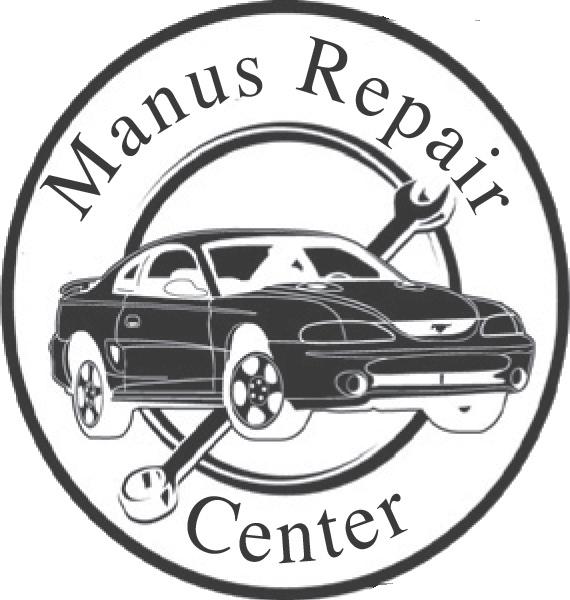
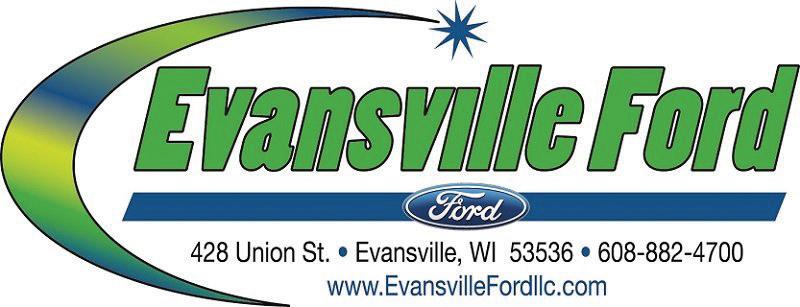


Road trips remind drivers of just how thrilling the open road can be. For millions of individuals, nothing provides a sense of escapism as effectively as the open road.
Though road trips can be liberating, they do not allow a complete escape from reality, something drivers realize when the time comes to fill up the gas tank.
Gas prices fell considerably by midDecember 2023, dipping to an average of $3.12 per gallon of regular by the middle of that month according to data from AAA.
That marked a significant decline from just a month earlier, when prices for a gallon of regular gas averaged $3.36.
But drivers know prices can spike just as quickly as they drop, so it pays dividends to recognize strategies to conserve fuel. Such strategies can be especially beneficial for drivers about to embark on a road trip.
• Slow down. Pushing the pedal to the medal might be a romantic, if unsafe, notion of how to drive on a road trip. But that approach can be costly at the pump.
According to the U.S. Department of Energy, every five miles per hour motorists drive over 50 miles per hour is the equivalent of paying $0.30 more per gallon of gas. That estimate is based on a gallon of gas costing $4.32, but drivers can still conserve a considerable amount of fuel by slowing down.
• Steer clear of city driving. The stopand-go traffic that is a hallmark of city driving can compromise fuel efficiency.
The Office of Energy Efficiency &
Renewable Energy notes that rapid acceleration and braking, which is hard to avoid when driving through cities with lots of stoplights and pedestrians, can lower gas mileage by as much as 40 percent.
• Avoid rooftop cargo. Rooftop cargo boxes might be a necessity when a car is packed with passengers. But these luxuries come at a steep cost.
A study from the Oak Ridge National Laboratory found that rooftop cargo boxes can reduce fuel efficiency by as much as 17 percent on the highway and as much as 25 percent on interstates where drivers drive at speeds between 65 and 75 miles per hour.
The DOE reports that rear-mount cargo boxes are much more efficient, so drivers looking to conserve fuel may want to pack light and/or opt for rearmount cargo boxes instead of rooftop boxes.
• Utilize cruise control. The auto manufacturer Kia estimates that utilizing the cruise control function on a vehicle can save drivers as much as 14 percent on fuel. Cruise control is not advisable when driving in cities or on roads with stoplights.
However, when driving on interstates, driving at the same continuous speed helps drivers avoid constant accelerations and decelerations, which compromise fuel efficiency.
When the open road beckons, drivers can make their road trips more affordable by implementing various strategies to conserve fuel.





Few things can be as unsettling when behind the wheel as a sudden noise. Noises coming from a car can indicate a host of issues, and that’s one reason why such sounds tend to be so different. Quickly identifying what’s behind car noises can make for safer driving and potentially save drivers substantial amounts of money.
Problem: Loose lug nut in a hub cap
This noise can be loud and unsettling, but the good news is that it’s often a simple fix if addressed immediately. The automotive insurance experts at Geico note that a noise that sounds like coins rattling around in a dryer is likely a loose lug nut in a hubcap.
The lug nut might have become loose if a wheel was not tightened sufficiently after a recent maintenance appointment or even if drivers changed a tire on their own. The longer drivers wait to address this, the more dangerous and costly it could become, as it could have an effect on the wheel bearings. If addressed promptly, the damage is likely minimal.
Problem: Various issues
A knocking noise from the engine typically sounds like repeated tapping. The noise will often become louder as the vehicle accelerates. Various issues can be behind the knocking sound, and drivers should avoid self-diagnosing the problem, even if they’ve experienced it in the past with the same or a different vehicle. Some drivers hear knocking because they’re using 87 octane fuel instead the of the high-performance and more expensive fuel the owner’s manual recommends (this could be a common problem in recent months given the meteoric rise in fuel prices).
Another potential cause of engine knock could be problems with the pistons or
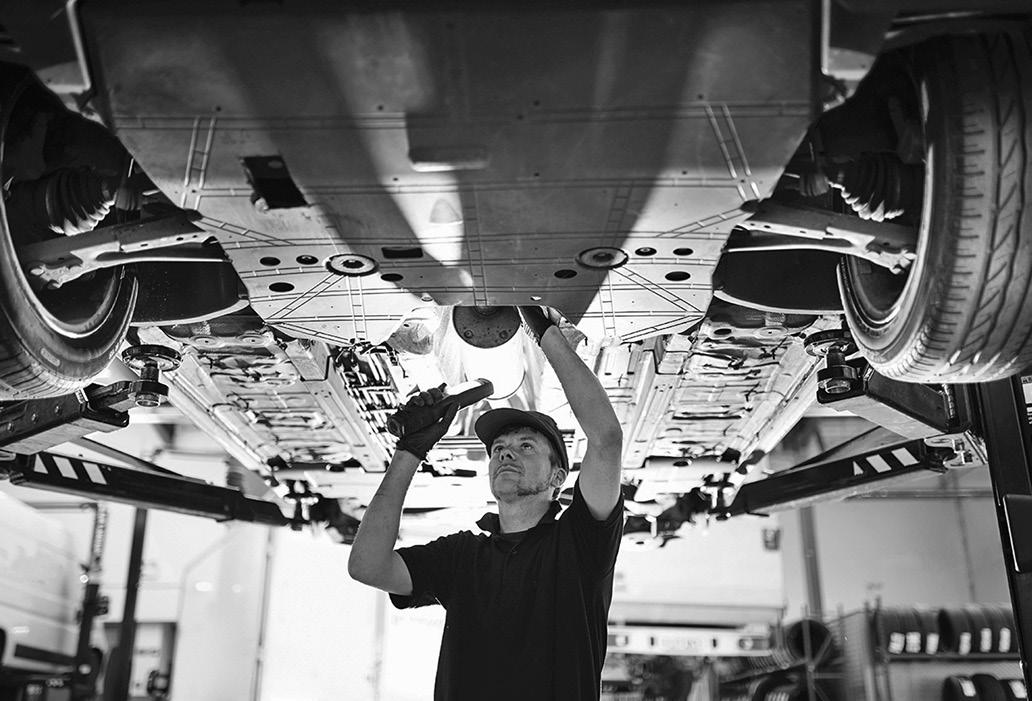
crankshaft. Regardless of what’s causing engine knocking, drivers are urged to take their vehicle to a mechanic promptly, as the cost of repairs is likely to rise the longer knocking goes untreated.
Problem: Issue with the serpentine belt
A squealing noise at start-up is among the more annoying noises a driver can hear. This sound is often indicative of a worn or
damaged serpentine belt, which connects the crankshaft to the alternator, power steering and additional components.
Thankfully, a worn down serpentine belt is a relatively inexpensive repair, though it’s important that it be addressed promptly.
Squealing at start-up also could indicate a loose tensioner, which is designed to keep the serpentine belt at a certain tightness and tension, or wear and tear
to the belt due to parking outside. These issues can be addressed by readjusting or replacing the tensioner or replacing the serpentine belt, particularly if the part is old.
No one wants to hear noises coming from their vehicles. However, such noises should be addressed promptly, as the quickness of drivers’ responses could make the difference between a simple, less costly fix and a more time-consuming, expensive repair.
The last few years have not proven the most advantageous times for new car buyers. According to the Consumer Price Index Summary from the United States Bureau of Labor Statistics, buyers paid 12.2 percent more for new vehicles in January 2022 than they had in January 2021.
Faced with such a significant increase in price, many drivers understandably want to keep their current cars longer than they might have initially planned.
Data released by S&P Global Mobility in early 2022 indicated that the average vehicle on the road is 12 years and two months old, which marked the highest number in the 20-plus years such information was tracked.
A host of variables affect how long drivers keep their cars, but the rising cost of new vehicles has undoubtedly compelled many drivers to aspire to keep their cars for longer periods of time. Aging cars may require a little more TLC than vehicles that are right off the dealership lot. But the following are three simple tips that can help drivers keep their cars running longer.
1. Become a more careful driver. A careful approach when behind the wheel is safer than aggressive driving and beneficial for your vehicle.
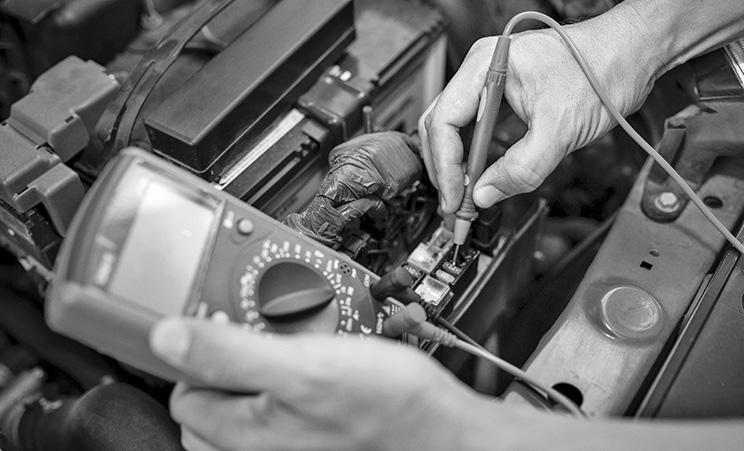
When starting, avoid revving the engine, which needlessly wears it down. When out on the road, avoid rapid accelerations, which also contributes to needless wear and tear. Even excessive idling can adversely affect the engine, so keep winter warm-ups to around 30 seconds to prevent damage to engine components.
2. Know when and how to fill up. Every
driver has likely visited a filling station when an oil tanker is busily filling the tanks.
That’s traditionally been considered a less than ideal time to fill up, as the theory is that filling the tanks stirs up sediment that could then find its way into consumers’ gas tanks, adversely affecting their vehicles. However, that’s often dependent on the station itself and how
much its owners prioritize maintenance of the tank and filtration systems. Drivers who trust their local station owners can likely fill up when the tankers are present without worry. In addition, avoid topping off once the nozzle clicks when filling up.
The U.S. Environmental Protection Agency notes that topping off is harmful to the planet and the vehicle, as gasoline needs room to expand. When you top off, the extra gas may damage the vapor collection system and cause the vehicle to run less efficiently.
3. Change oil more frequently as the vehicle ages. It’s true that modern vehicles no longer require oil changes for every 3,000 miles driven. However, as vehicles age, drivers and their vehicles’ engines may benefit from more frequent oil changes than the owner’s manual necessarily recommends.
Oil changes remove dirt and metal particles from the engine, potentially contributing to a longer life expectancy. More frequent changes can be especially beneficial for vehicles that are routinely driven in stop-and-go traffic.
Rising vehicle costs have compelled many drivers to keep their cars longer than they initially planned. Some simple strategies can help drivers achieve that goal.
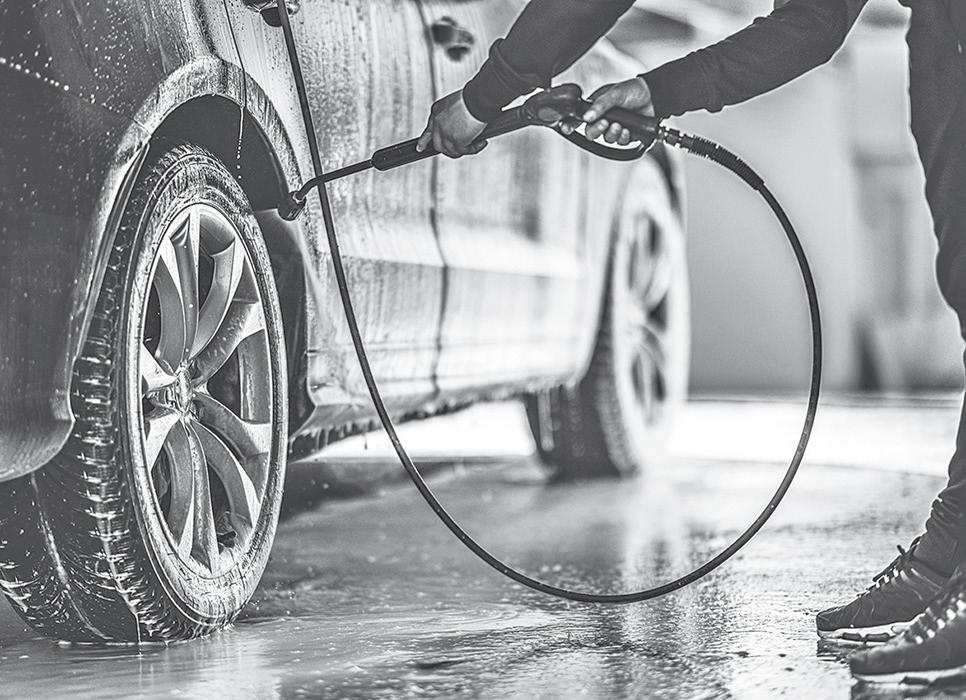
in their vehicles in the future should realize that a well-maintained car can bring in as much as 20 percent more for above-average condition, according to Kelley Blue Book. Maintaining a clean and shiny vehicle can protect its long-term value.
Remove salt
than cosmetic.
Extend the life of paint
Dirt and debris can build up on the paint surface and eventually lead to scratches and other damage. Bird droppings and sap can be corrosive. Washing will help remove grime and protect the paint in the process.
Preserve the vehicle’s value
Drivers who plan to sell or trade
Drivers who live near the ocean or in areas where roads are salted in the winter to melt snow may have cars with high salt corrosion rates. Unless it’s washed off frequently, salt can take its toll, leading to damage.
Drivers have felt pain in their wallets at the fuel pump in recent years. Dirty cars may be less aerodynamic and less fuel-efficient
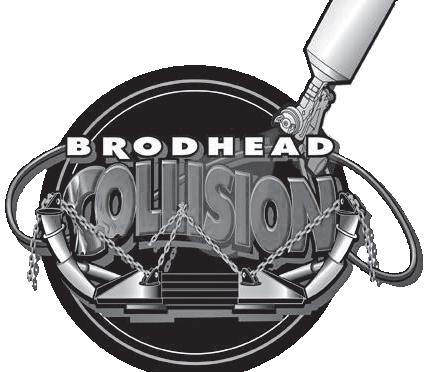
When your car’s air conditioning fails, it can be more than a nuisance, it can become a health and safety matter.
Most of us first notice an air conditioning problem when the car gets hot and muggy. But those with allergies can be quickly exposed to irritants when the windows are rolled down.
A cool passenger cabin has also been cited as a factor in keeping the driver alert.
Beyond just cooling the car, the vehicle’s air conditioning system is necessary for defogging the inside of the windows. Without it, the occupants can be at risk in bad weather.
The the air conditioning system will give many hints that something isn’t right. Unusual noises, poor air flow, or blowing hot air instead of cold are all signs of a problem. Each problem could have different causes, perhaps a broken belt, a component failure, an electrical problem, or loss of the pressurized refrigerant.
It’s always best to take your car to a professional service provider who offers full system service and uses the proper tools to find the problem.
If refrigerant is leaking, simply adding more won’t fix it! Refrigerant will continue to escape and the loss may cause other expensive damage as well. Why risk it? Additionally, today’s refrigerant (R-134a) is a potent greenhouse gas regulated by the U.S. EPA.
Professional service shops are required to recover and recycle the chemical, and it is illegal for anyone to release it into the atmosphere.
as a result. Keeping a car clean may improve its fuel efficiency.
A car that is routinely and properly washed and waxed is less vulnerable to damage from the sun’s ultraviolet rays.
Car washes are not only about the exterior. Keeping a clean and tidy interior can help improve the air quality inside of the vehicle and prolong the life of upholstery, mats and interior components.
Car washes should be a routine part of vehicle maintenance. Professional car washes tend to be more eco-friendly than washing a car at home, so drivers are urged investigate their plans and features. (METRO CREATIVE)
The best refrigerant for any car is the one initially installed. It’s important to know that since 1995, no automaker has approved any refrigerant other than R-134a for use in their vehicles A/C systems.
Newer cars and trucks use even less refrigerant in newer, more efficient systems. These systems require a precise amount of refrigerant and won’t tolerate mistakes during service.
Too little gas in these systems will cause poor cooling and put other, expensive components at risk because there is not enough lubricant circulating. A more common error, overcharging, puts too much refrigerant into the system and risks damage from much higher internal pressures.
The days of just “topping off” a system are gone, and professional repair shops have the tools and the knowledge to diagnose, repair and recharge a failed system.
To learn more about your vehicle’s air conditioning system, visit the Mobile Air Conditioning Society Worldwide website at www. macsw.org.
